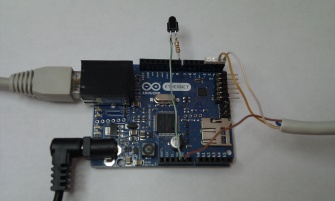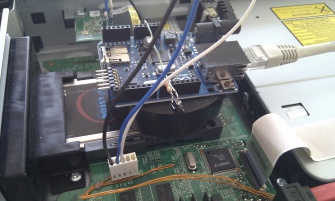Difference between revisions of "Ethernet multi-function Interface"
m (→Arduino sketch) |
m (Bug fix) |
||
| Line 405: | Line 405: | ||
byte bSequential=0; | byte bSequential=0; | ||
| − | for (long i=Addr; i<Size; i+=32) | + | for ((long i=Addr; i<Addr+Size; i+=32) |
{ | { | ||
unsigned char Data[32]; | unsigned char Data[32]; | ||
| + | for (int i=0; i<32; i++) Data[i]=0xff; | ||
Samsung::ReadEeprom(Device, (bSequential) ? -1:i, Data, 32); | Samsung::ReadEeprom(Device, (bSequential) ? -1:i, Data, 32); | ||
bSequential=1; | bSequential=1; | ||
Revision as of 17:39, 13 September 2012
Using an Arduino Ethernet board, you can send IR codes to your TV or BD
With the same board, you can also interface to the Serial Console, and read your device config eeprom.
Contents
What you can do
- Send IR codes to your TV, PVR or BD, with an URL in your browser
- Use telnet to have the Serial Console on your PC or smartphone
- Read your config eeprom
Bill of materials
- Arduino Ethernet board (see Arduino)
Alternatively, an Arduino Uno with an Ethernet shield could also be used
- IR led (SFH4510 for example) or RED Led (Clear Type RED LED's are emitting more than enough light at IR spectrum)
- 220 ohms resistor to limit current in the IR led
- If you plan to use the telnet interface to the Serial Console, make sure you have a 100 ohms resistor on both RX and TX signals (Arduino TX/RX are 5v !)
How to use it
- Upload the following sketch into your Arduino
- Connect the IR or RED led with its resistor on pin 8 on the Arduino
- Connect power and network
- Find the IP address of the board on your DHCP (or use the static IP embedded in the sketch if you don't have DHCP)
- Use your browser to send an URL to the board (see format below)
- If you want to use telnet to connect to the Serial Console :
* Connect your Serial Console signals TX&RX to the Arduino board pins 0&1 (with 100 ohms resistors) * Use Putty with options 'Local Echo' and 'Local line editing' forced to OFF
- If you want to read your config eeprom :
* Connect the eeprom SDA&SCK signals to the Arduino board pins A4/A5 (with a 100 ohms resistors) * Connect the eeprom GND to 0v
URL format to send IR codes
The format is http://IP/ir.htm?data=XX&type=Y&device=ZZZZ where
- IP is the Arduino board IP address
- XX is the IR code to send
- Y is 0 for TV/PVR frame format and 1 for BD frame format
- ZZZZ is the device code (0707 for TV, 0505 for PVR, 301A for BD)
The IR codes are listed at Key codes
- For TV/PVR, use the 'code' column
- For BD, use the 'BD-IR code' column
For example:
To get the Service Menu on your TV, use the 2 following URLs :
Please note that you cannot send KEY_FACTORY to a BD, as the corresponding code is not know yet
To have a kind of Wake Up on LAN on your BD player, use
To switch to channel 1 :
- On a TV : http://IP/ir.htm?data=65&type=0&device=0707
- On a BD : http://IP/ir.htm?data=81&type=0&device=301A
URL format to read config Eeprom
The format is http://IP/read?read?format=F&device=D&addr=A&size=S
- IP is the Arduino board IP address
- F is 0 to get the result in html, 1 to download a binary file
- D is the Eeprom device identification (80 by default)
- A is the starting address for reading (0 by default)
- S is the number of bytes to read (default=256)
For example:
BD-E8300 is equiped with a 24512 eeprom (64 kbytes)
To download its whole config :
or :
Eeprom connection :
IR frames format
BD players use a modified IR frame format that TV and PVR. The reason is that samsung increased the data field length from 8 to 12 bits The general format is now :
- Start bit
- Device ID (16 bits - 0707 for TV, 301A for BD)
- For BD only : Stop bit and data MSB on 4 bits
- Data LSB
- Data LSB 1's complement
A frame for BD :
Arduino sketch
// ---------------------------------------------------------------------
// Samsung multi-function ethernet interface
// - Send IR frame with http get requests
// - Debug console on telnet
// - Read & Write I2C config eeprom
//
// 29-06-2012 / v1.1 / oga83
// 11-09-2012 / v1.1 / oga83
// Added optionnal 'crc' url parameter for testing IR (allow to force CRC)
// Added I2C interface to read/write config eeprom
//----------------------------------------------------------------------
#include <SPI.h>
#include <Ethernet.h>
#include <Wire.h>
#define IRPIN 8 // IR led is connected on pin 8
#define LEDPIN 9 // Onboard led - blink at 2 Hz
// Debug console TX signal connected on 0
// Debug console RX signal connected on 1
// I2C Eeprom : SDA connected on A4
// I2C Eeprom : SCK connected on A5
byte mac[] = { 0x90, 0xA2, 0xda, 0x00, 0xe6, 0x5e }; // Arduino Ethernet board MAC address
IPAddress ip(192,168,1,178); // Default static IP if no DHCP
EthernetServer HttpServer(80); // HTTP is used to send IR commands
EthernetServer TelnetServer(23); // Telnet is used for Serial Console
// ---------------------------------------------------------------------
// Utilities
// ---------------------------------------------------------------------
// Convert a hex string to unsigned int
unsigned int HexToULong(char *s)
{
unsigned long u=0;
while (*s)
{
char c=*s++;
// Convert to uppercase
if (c>='a') c&=0xdf;
// Exit if not hex digit
if ((c<'0' || c>'9') && (c<'A' || c>'F')) break;
// Convert digit
u<<=4;
u|=c-((c>'9') ? 'A'-0xa:'0');
}
return u;
}
// ---------------------------------------------------------------------
// Samsung IR class
// ---------------------------------------------------------------------
class Samsung
{
private:
// Send a 36kHz-modulated pulse
static void Pulse(void)
{
byte i;
for (i=0; i<21; i++)
{
digitalWrite(IRPIN, HIGH);
delayMicroseconds(10); // Value adjusted with oscilloscope
digitalWrite(IRPIN, LOW);
delayMicroseconds(10); // Value adjusted with oscilloscope
}
}
// Send a bit
static void SendIRBit(byte b)
{
Pulse();
if (b)
delayMicroseconds(1390);
else
delayMicroseconds(430);
}
// Send 4 bits
static void SendIRNibble(byte b)
{
byte i;
for (i=0; i<4; i++)
SendIRBit((b>>i)&1);
}
// Send a byte
static void SendIRByte(byte b)
{
byte i;
for (i=0; i<8; i++)
SendIRBit((b>>i)&1);
}
public:
// Send an IR command
// Type is 0 for TV, 1 for BD
// Device is 0x0707 for TV, 0x301A for BD
// Crc should be ~Command, except for tests
static void SendCommand(char Type, unsigned int Device, unsigned int Command, unsigned char Crc)
{
byte i;
// Disable interrupts
cli();
// Start bit
for (i=0; i<8; i++) Pulse();
delayMicroseconds(4500);
// Send Device Id
SendIRByte(Device>>8);
SendIRByte(Device&0xff);
// BD Player
if (Type==1)
{
// Stop bit
Pulse();
delayMicroseconds(4500);
// Send Data
SendIRNibble(Command>>8);
}
SendIRByte(Command);
SendIRByte(Crc);
// Stop bit
Pulse();
delayMicroseconds(4500);
// Re-enable interrupts
sei();
}
// Read Eeprom
static void ReadEeprom(byte device, long addr, byte *data, int count)
{
if (addr!=0xffffffff)
{
Wire.beginTransmission(device);
Wire.write(addr>>8);
Wire.write(addr);
Wire.endTransmission();
}
Wire.requestFrom((int)device, count);
for (int i=0; i<count; i++)
{
if (!Wire.available()) break;
data[i]=Wire.read();
}
}
// Write Eeprom
static void WriteEeprom(byte device, long addr, byte *data, int count)
{
Wire.beginTransmission(device);
Wire.write(addr>>8);
Wire.write(addr);
for (int i=0; i<count; i++) Wire.write(data[i]);
Wire.endTransmission();
}
};
// ---------------------------------------------------------------------
// Initialization
// ---------------------------------------------------------------------
void setup()
{
// Led
pinMode(LEDPIN, OUTPUT);
digitalWrite(LEDPIN, HIGH);
// IR Led
pinMode(IRPIN, OUTPUT);
digitalWrite(IRPIN, HIGH);
// I2C
Wire.begin();
// Serial Console
Serial.begin(115200);
// Initialize Ethernet. Try DHCP, otherwise static IP
if (Ethernet.begin(mac)==0)
Ethernet.begin(mac, ip);
// Initialize HTTP server
HttpServer.begin();
// Initialize Telnet server
TelnetServer.begin();
}
// ---------------------------------------------------------------------
// Main Program
// ---------------------------------------------------------------------
char HttpFrame[256]; // General buffer for Http frames
char TelnetFrame[256]; // General buffer for Telnet frames
char Buffer[32]; // General buffer
boolean iStateLed=false; // Used for led blinking
unsigned long timeLastLedMs=0; // Used for blinking delay
void loop()
{
// -------------------------------------------------
// LED blinks at 2Hz
// -------------------------------------------------
if (millis()>timeLastLedMs+250)
{
timeLastLedMs=millis();
digitalWrite(LEDPIN, (iStateLed) ? HIGH:LOW);
iStateLed=!iStateLed;
}
// -------------------------------------------------
// Handle HTTP requests
// Example :
// To send KEY_1 on BD :
// http://IP/ir.htm?data=81&type=1&device=301a
// -------------------------------------------------
EthernetClient client = HttpServer.available();
if (client)
{
char *ptr=HttpFrame;
int n=0;
while (client.connected() && client.available())
{
if (n++<sizeof(HttpFrame))
*ptr++=client.read();
else
client.flush();
}
*ptr=0;
if (n>0)
{
__FlashStringHelper *HtmlHeader=F("HTTP/1.1 200 OK\r\nContent-Type: text/html\r\n");
// -------------------------------------------------
// Send Samsung IR command
// -------------------------------------------------
ptr=strstr(HttpFrame, "/ir.htm?");
if (ptr)
{
byte Type=0, Crc;
unsigned int Device=0x0707, Data=0;
ptr=strstr(HttpFrame, "data=");
if (ptr) Data=HexToULong(ptr+5);
ptr=strstr(HttpFrame, "type=");
if (ptr) Type=HexToULong(ptr+5);
ptr=strstr(HttpFrame, "device=");
if (ptr) Device=HexToULong(ptr+7);
// Next parameter is optional and can be used for tests
Crc=~Data;
ptr=strstr(HttpFrame, "crc=");
if (ptr) Crc=HexToULong(ptr+4);
Samsung::SendCommand(Type, Device, Data, Crc);
client.println(HtmlHeader);
client.println("OK !");
client.stop();
return;
}
// -------------------------------------------------
// Read Eeprom
// -------------------------------------------------
ptr=strstr(HttpFrame, "/read");
if (ptr)
{
byte Device=0, Format=0x50;
unsigned long Size=0x100, Addr=0;
ptr=strstr(HttpFrame, "addr=");
if (ptr) Addr=HexToULong(ptr+5);
ptr=strstr(HttpFrame, "size=");
if (ptr) Size=atol(ptr+5);
ptr=strstr(HttpFrame, "device=");
if (ptr) Device=atoi(ptr+7);
ptr=strstr(HttpFrame, "format=");
if (ptr) Format=atoi(ptr+7);
if (Format==0)
{
client.println("HTTP/1.1 200 OK\r\nContent-Type: text/plain\r\n");
}
else
client.println("HTTP/1.1 200 OK\r\nContent-Type: binary/octet-stream\r\n");
byte bSequential=0;
for ((long i=Addr; i<Addr+Size; i+=32)
{
unsigned char Data[32];
for (int i=0; i<32; i++) Data[i]=0xff;
Samsung::ReadEeprom(Device, (bSequential) ? -1:i, Data, 32);
bSequential=1;
if (Format==0)
{
sprintf(Buffer, "%04lx: ", i); client.print(Buffer);
for (int j=0; j<32; j++)
{ sprintf(Buffer, "%02X ", Data[j]); client.print(Buffer); }
for (int j=0; j<32; j++)
{ client.write((Data[j]<=0x20 || Data[j]>0x7f) ? '.':Data[j]); }
client.println("");
client.flush();
}
else
{
for (int j=0; j<32; j++)
client.write(Data[j]);
}
}
client.stop();
return;
}
// -------------------------------------------------
// Write Eeprom
// -------------------------------------------------
ptr=strstr(HttpFrame, "/write");
char *ptrAddr=strstr(HttpFrame, "addr=");
char *ptrData=strstr(HttpFrame, "data=");
if (ptr && ptrAddr && ptrData)
{
byte Device=0, Data;
unsigned long Addr;
Addr=HexToULong(ptrAddr+5);
Data=HexToULong(ptrData+5);
ptr=strstr(HttpFrame, "device=");
if (ptr) Device=atoi(ptr+7);
Samsung::WriteEeprom(Device, Addr, &Data, 1);
client.println("HTTP/1.1 200 OK\r\nContent-Type: text/plain\r\n");
Data=~Data;
Samsung::ReadEeprom(Device, Addr, &Data, 1);
sprintf(Buffer, "%02X ", Data);
client.print(Buffer);
client.stop();
return;
}
// send an error !
client.println(HtmlHeader);
client.println(F("Error !"));
delay(1);
}
client.stop();
}
// -------------------------------------------------
// Telnet Serial Console Interface
// Configure Putty with :
// - "Local Echo : Force off"
// - "Local line editing : Force off"
// -------------------------------------------------
client = TelnetServer.available();
if (client)
{
char *ptr=TelnetFrame;
int n=0;
while (client.connected() && client.available())
if (n++<sizeof(TelnetFrame)) *ptr++=client.read();
*ptr=0;
// Sends telnet buffer to Serial Console
if (n>0) Serial.write(TelnetFrame);
}
// Anything received from Serial Console ?
char *ptr=TelnetFrame;
int n=0;
while (Serial.available())
if (n++<sizeof(TelnetFrame)) *ptr++=Serial.read();
*ptr=0;
// Send it to telnet
if (n>0) TelnetServer.write(TelnetFrame);
}
// ---------------------------------------------------------------------

